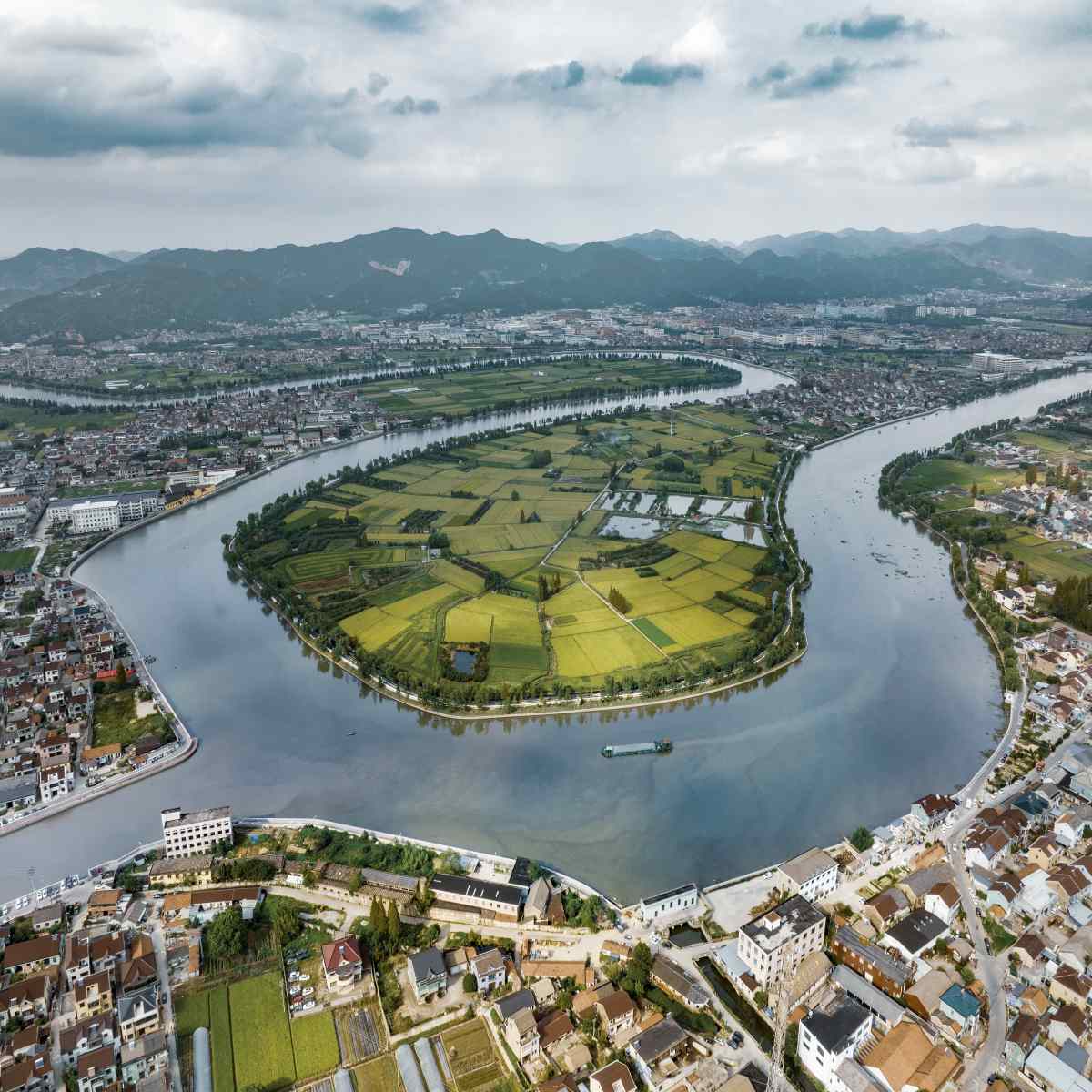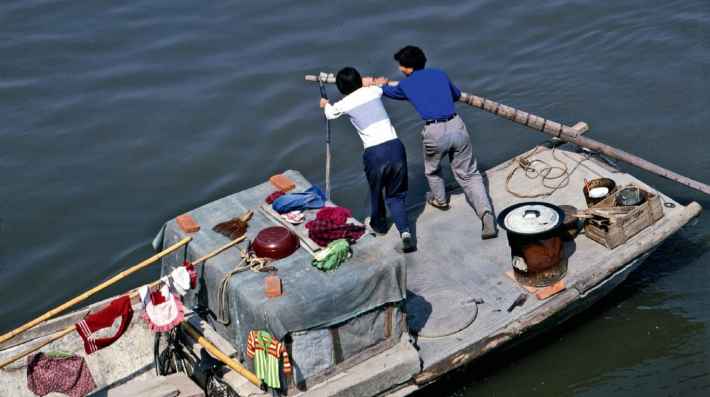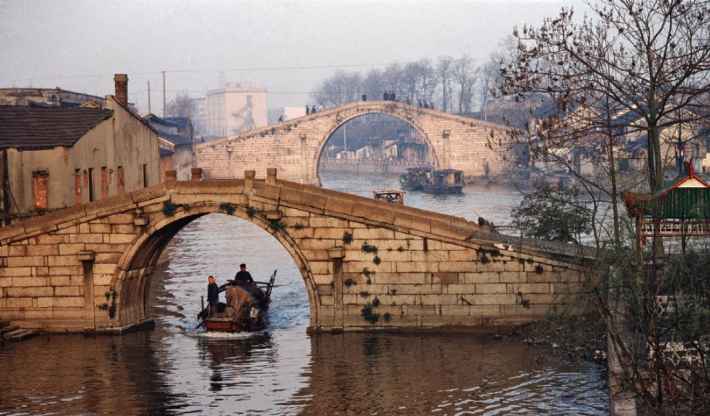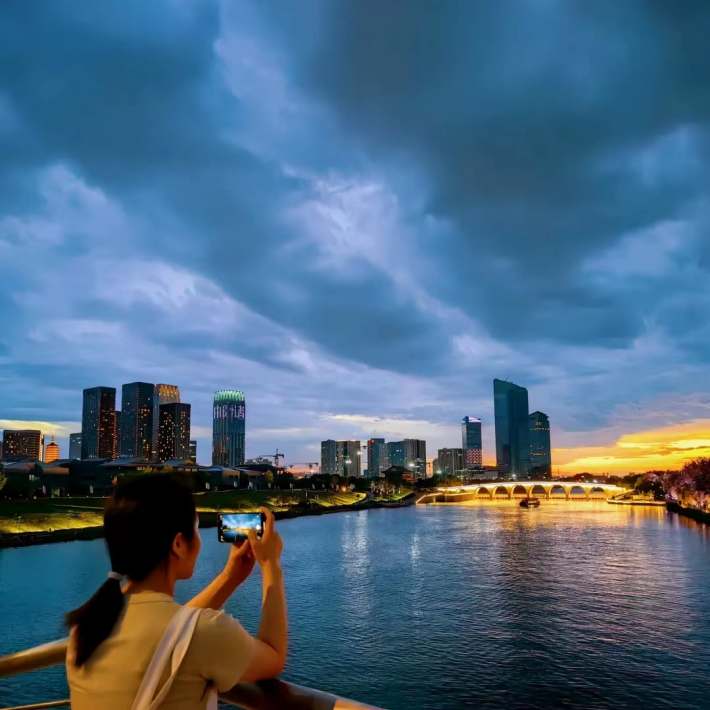The Grand Canal: China’s Flowing Memories

China’s Grand Canal boasts a history spanning over 2,500 years. Extending for more than 3,200 kilometers, it traverses eight provincial-level administrative regions including Beijing, Tianjin, Hebei, Shandong, Jiangsu, Zhejiang, Henan, and Anhui. The man-made waterway also crosses several major rivers such as the Haihe, Yellow, Huaihe, Yangtze, and Qiantang. In 2014, the Grand Canal earned a place on the World Cultural Heritage List.
In 2019, the Grand Canal was included in China’s new program to build national cultural parks. The extraordinary water conservancy project, crafted by Chinese ancestors, embodies dynamism, practicality, and inclusiveness, showcasing the Chinese nation’s remarkable ability to shape and harness nature while coexisting harmoniously with it.

Thousands of people working on a project to dredge the Jiangsu-Zhejiang section of the Grand Canal in 1970. (Photo by Tang Desheng)
The Grand Canal persists as a waterway of political significance. It played a pivotal role in promoting national unity, cultural amalgamation, and uninterrupted flow of civilization. The Hangou Canal was dug by the Wu State in the Spring and Autumn Period (770-476 B.C.), the Ling Canal was constructed by Qin Shi Huang, the First Emperor of the Qin Dynasty (221- 207 B.C.), and the Cao Canal was built in the Han Dynasty (202 B.C.-220 A.D.). These canals were connected and expanded into the Grand Canal during the reign of Emperor Yang Guang of the Sui Dynasty (581-618). The Grand Canal facilitated construction of the Forbidden City in the Ming Dynasty (1368-1644) and southern inspection tours made by emperors Kangxi and Qianlong of the Qing Dynasty (1644-1911). The Grand Canal connected the Haihe, Yellow, Huaihe, Yangtze, and Qiantang rivers, acting as a vital link uniting the north and south of China. Historically, it served as a crucial pillar for realization of a unified nation. “The completion of the Grand Canal firmly laid the foundation for unity of the south and the north.” declared Liang Qichao, a celebrated scholar in modern China.
The Grand Canal also facilitated diplomacy. In the past, many foreign diplomatic missions traveling to and from China would make use of this extensive waterway. During the Yuan Dynasty (1271-1368), famous Italian traveler Marco Polo resided in China for 17 years and visited numerous cities along the Grand Canal. He even dubbed Hangzhou “the most beautiful and magnificent city in the world.” The Ming and Qing dynasties witnessed frequent exchanges of ideas and people between China and foreign countries. Western missionaries like Matteo Ricci traveled from Nanjing to Beijing via the Grand Canal. Moreover, envoys from various countries including the Netherlands, the United Kingdom, Japan, and Korea usually made their return journey to the south via the canal. For example, Korean envoy Choe Bu once traveled from Hangzhou to Beijing via the Grand Canal. Upon his return to Korea, he documented his experience in a book titled A Record of Drifting Across the Southern Brocade Sea, which contained numerous observations and accounts of the Grand Canal.

A household on the Grand Canal in Wuxi City, Jiangsu Province, in 1982.(Photo by Liu Shizhao)
The Grand Canal also served as the ancient economic lifeline for China. After its completion, the man-made waterway hosted substantial boat traffic, facilitating the transport of vital commodities such as grain, timber, copper, and salt. The enhanced connectivity along the Grand Canal breathed new life into the exchange of goods in China’s most economically advanced regions, giving rise to the renowned Grand Canal economic belt. During the Qing Dynasty, taxation offices along the Grand Canal collected taxes amounting to 2.5 to 3 million taels of silver each year, comprising 50-60 percent of the nation’s annual tax revenue. This underscored its pivotal role as a cornerstone of the country’s finance.
The Grand Canal is also a river of culture. It not only brought significant changes to daily life in ancient China by making travel and trade more convenient, but also profoundly enriched the spiritual world of ancient Chinese people. The far-reaching influence of the canal can be seen in various domains including classical literature, Kunqu Opera, Peking Opera, calligraphy, and painting. For example, a Tang Dynasty (618-907) poem celebrates Suzhou with the lines “Cold Mountain Temple outside Suzhou City, the night bell tolls on a guest’s boat.” Hangzhou was immortalized in the verse “West Lake looks like the fair lady at her best, whether she is richly adorned or plainly dressed.” Such poetic expressions have breathed life into the history of the cities along the Grand Canal.

Ancient stone bridges on the Grand Canal in Suzhou City, Jiangsu Province, in 1982.(Photo by Liu Shizhao)
Almost every city along the route has inscribed the historical essence of the Grand Canal within its very being, serving as a wellspring of inspiration for the creative minds of ancient Chinese literati. For instance, in Jining, Shandong Province, famous poet Li Bai of the Tang Dynasty composed timeless masterpieces such as “Bringing in the Wine,” “The Hard Road of Shu,” and “A Departing Song of Traveling to Tianmu in a Dream.” In the Northern Song Dynasty (960-1127), literary luminary Su Dongpo visited Changzhou in Jiangsu Province 14 times, ultimately drawing his last breath in the city.
The four major classical novels of Chinese literature have deep-rooted connections to the Grand Canal. Wu Cheng’en, author of Journey to the West, hailed from Huai’an, Jiangsu Province. He spent his childhood alongside the canal, absorbing stories of travelers journeying from the south to the north. Luo Guanzhong, the author of Romance of the Three Kingdoms, was a native of Taiyuan, Shanxi Province. At the age of 14, he experienced the loss of his mother and subsequently lived with his father in the vicinity of Suzhou and Hangzhou, which are in close proximity to the Grand Canal. Shi Nai’an, author of Water Margin, led a life of seclusion in Huai’an, where he penned this epic tale. As for Dream of the Red Chamber, author Cao Xueqin was raised in the watery landscapes along the Yangtze River. Notably, his father, Cao Yong, and his grandfather, Cao Yin, were both involved in textile production in Jiangning, which is now a part of Nanjing.

People pick water chestnuts aside an ancient salt transportation canal in Taizhou City, Jiangsu Province, October 2022. (Photo by Cheng Xu)
The flourishing of traditional Chinese opera owes a significant debt to the Grand Canal. Kunqu Opera, named after the Kunshan style in Suzhou, had held a prominent position since the mid-Ming Dynasty. It originated in Suzhou and radiated outwards along the Grand Canal and the Yangtze River, eventually becoming the most influential theatrical genre from the mid-Ming Dynasty to the mid-Qing Dynasty. The birth of Peking Opera owes much to the Grand Canal. During Emperor Qianlong’s 80th birthday celebration, four distinguished Hui Opera troupes voyaged to Beijing by boat along the Grand Canal to perform for the emperor. Later, Hui Opera incorporated elements from Chu Opera, Qin Opera, Kunqu Opera, and other regional operatic traditions and eventually evolved into Peking Opera, a noted representative of China’s national theatrical heritage.
Numerous calligraphy and painting works also share a direct connection to the Grand Canal. Particularly renowned are two national treasures: Along the River During the Qingming Festival by Zhang Zeduan from the Northern Song Dynasty, a scroll painting over five meters in length vividly depicting the bustling city of Kaifeng in Henan Province, and Prosperous Suzhou by Xu Yang from the Qing Dynasty, an impressive 12-meter-long scroll that showcases the opulence of Suzhou during the Qing period.

A visitor captures the beautiful scenery on the Grand Canal in Tongzhou District, Beijing, July 2023. (Photo by Cheng Xu)
In 1855, the course of the Yellow River changed after a breach, and the emergence of new transport means like trains and marine vessels caused shipping along the Grand Canal to gradually wane in modern times. Following the founding of the People’s Republic of China in 1949, the government placed a significant emphasis on water management, leading to gradual revitalization of the Grand Canal. In 2019, the Grand Canal was designated as a national cultural park. In 2022, with the assistance of the South-to-North Water Diversion Project, the Grand Canal was fully restored and its entire length reopened. Today, the section of the Grand Canal in northern Jiangsu continues to serve as a critical conduit for shipping coal from the north to the south, with an annual shipping volume surpassing 300 million tons.
For more than 2,500 years, the Grand Canal has served as both a witness and an active participant in China’s ancient history. It directly participated in the shift of China’s economic center of gravity from north to south and its political center from northwest to north. It testifies to the possibilities for a united nation to deftly leverage its advantages to harmoniously coordinate political, military, and economic centers, crafting them into a seamless whole.
The Grand Canal serves as a concrete representation of the continuity, innovation, unity, inclusiveness, and peaceful nature of Chinese civilization. Rather than being relegated to existence only in written text and historical documents like so many other ancient structures, the waterway has survived as a flowing, vibrant testament and a dynamic repository of national and cultural memories that persist in perpetuity.
The author is a vice dean of the School of Humanities and a professor of history at Tsinghua University.